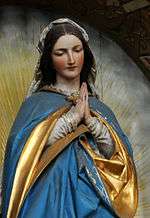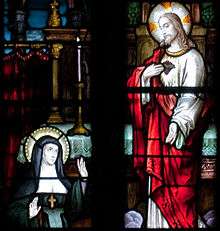Our Lady of Kibeho
Our Lady of Kibeho is the name given to Marian apparitions concerning several adolescents, in the 1980s in Kibeho, south-western Rwanda. The apparitions communicated various messages to the schoolchildren, including an apocalyptic vision of Rwanda descending into violence and hatred, possibly foretelling the 1994 Rwandan genocide.[2]
| Our Lady of Kibeho | |
|---|---|
| Location | Kibeho Rwanda, Africa |
| Date | 1980s |
| Witness | Alphonsine Mumureke Nathalie Mukamazimpaka Marie Claire Mukangango |
| Type | Marian apparition |
| Approval | June 29, 2001[1] Bishop Augustin Misago Diocese of Gikongoro |
| Shrine | Kibeho, Rwanda |
In 2001, the local bishop of the Catholic Church officially recognised the visions of three schoolchildren as authentic.[3]
| Part of a series on the |
| Mariology of the Catholic Church |
|---|
 Virgo by Josef Moroder-Lusenberg |
|
|
|
|
|
|
Apparitions
Kibeho is a small village located in southwestern Rwanda. The apparitions there began on November 28, 1981, at a time of increasing tension between the Tutsi and Hutu groups. They occurred at Kibeho College, a secondary school for girls,[4] and included an apocalyptic vision of Rwanda descending into violence and hatred which many believe foretold the 1994 Rwandan genocide.
Over the course of the 1980s, the Virgin Mary appeared to three young women, identifying herself as Nyina wa Jambo (Kinyarwanda for “Mother of the Word”), which was synonymous with Umubyeyi W'Imana ("Mother of God").[5] The teenaged seers reported that the Virgin asked everyone to pray to prevent a terrible war. In the vision of August 19, 1982, they all reported seeing violence, dismembered corpses, and destruction.[6]
The longest series of visions were attributed to Alphonsine Mumureke, who had received the initial vision shortly after her admittance into Kibeho High School in October 1981 after her primary education, and the last on November 28, 1989. Anathalie Mukamazimpaka was the next one to have visions, which lasted from January 1982 to December 3, 1983. These emphasised endless prayer and expiation, with the Virgin even instructing Mukamazimpaka to perform penances through mortification of the flesh. Marie Claire Mukangango, who had initially bullied Mumureke at school because of the visions, herself experienced apparitions which lasted from March 2 to September 15, 1982. The Virgin told Mukangango that people should pray the Chaplet of the Seven Sorrows to obtain the favor of repentance.[7]
During his 1990 visit to Rwanda, Pope John Paul II exhorted the faithful to turn to the Virgin as a “simple and sure guide” and to pray for greater commitment against local divisions, both political and ethnic.[6]
Links with the Genocide
In the 100 days that followed the April 6, 1994 assassination of dictator and President of Rwanda Juvénal Habyarimana, 800,000 to over a million Rwandans were slaughtered by their countrymen and, in some cases, their next-door-neighbors. The Genocide was the culmination of intensifying animosity between the two ethnic groups – the Hutus and Tutsis – and the civil war that had preceded it.[8] Kibeho itself was the site of two huge massacres: the first at the parish church in April 1994, and the second a year later where more than 5,000 refugees who had taken shelter there were shot by soldiers.[9] Marie Claire Mukangango and her husband were among those killed in the April 1995 massacre.[6]
Approved visionaries
Only the visions of the first three seers (Alphonsine Mumureke, Nathalie Mukamazimpaka, and Marie Clare Mukangango, aged 17, 20, and 21, respectively) received the solemn approval of Augustin Misago, Bishop of Gikongoro.[10]
Non-approved visionaries
Others who claimed to have similar visions were Stephanie Mukamurenzi, Agnes Kamagaju, Vestine Salima, and Emmanuel Segastashya, the last of whom was previously a pagan and became a Christian evangelist. Segastashya’s alleged visions included meeting Christ in a beanfield.
Interpretation
The visions may be regarded as an ominous foreshadowing of the Rwandan genocide, and particularly the second Kibeho Massacre in 1995. The school where the visions occurred became a place of slaughter during the Genocide as dozens of children were shot and hacked to death by Hutu terrorists.[11] The visionaries had either fled the violence or were among the casualties of the Genocide.
Approval
Augustin Misago, the Bishop of Gikongoro, approved public devotion linked to the apparitions on 15 August 1988 (the Solemnity of the Assumption of Mary) and declared their authenticity on 29 June 2001.[5] He was accused in 1999 of involvement in the Rwandan Genocide, and acquitted on 24 June of the following year.[11]
The feast day of Our Lady of Kibeho is November 28, the anniversary of the initial apparition to Alphonsine Mumureke in 1981.[12]
Shrine
The Marian sanctuary at Kibeho was named "Shrine of Our Lady of Sorrows" in 1992.[5] The first stone was laid on 28 November 1992. In a 2003 agreement between the local ordinary and the Society of the Catholic Apostolate (Pallotines), the rectorate of the Shrine of Our Lady of Kibeho is entrusted to the Pallotine Fathers. The rector is appointed by the local bishop and the Regional Pallottine Rector.[13]
Cultural references
American playwright Katori Hall dramatized the events surrounding the apparitions in Our Lady of Kibeho, produced in New York in 2014.[14]
See also
- Marian apparitions
- Our Lady of Sorrows
- Kibeho Massacre
References
- "Dichiarazione del vescovo di Gikongoro in merito alle apparizioni di Kibeho" [Declaration of the Bishop of Gikongoro on the merits of the Kibeho apparitions] (in French). Holy See Press Office.
- Immaculée Ilibagiza, Steve Erwin. Our Lady of Kibeho: Mary Speaks to the World from the Heart of Africa. 2008, page xvii
- Curran, Bridget. The Miracles of Mary: Everyday Encounters of Beauty and Grace. 2010, page 128
- ""Kibeho parish", Kibeho Sanctuary". Archived from the original on 2016-03-05. Retrieved 2013-03-30.
- Bishop Augustin Misago of Gikongoro (2001-07-31). "Judgment on the apparitions of Kibeho". EWTN. Retrieved 2009-04-04.
- Rogers, Lois. "Our Lady of Kibeho", The Monitor, January 20, 2012, Diocese of Trenton
- "The Chaplet of the Seven Sorrows", Marians of the Immaculate Conception
- "Remembering Rwanda", The Monitor, January 20, 2012, Diocese of Trenton
- Linskey, Regina. "Our Lady of Kibeho: Forgotten apparitions", Catholic News, Singapore, Vol. 58, No. 25, December 7, 2008
- Misago, Augustin. "Judgement on the Apparitions of Kibeho"
- Simpson, Chris (2000-06-24). "A bishop tried over genocide". The Tablet. Archived from the original on 2016-02-19. Retrieved 2008-10-30.
- ""Our Lady of Sorrows (Kibeho)", La Carte Mariale du Monde". Archived from the original on 2014-12-05. Retrieved 2013-03-30.
- ""Pastoral Service", Kibeho shrine". Archived from the original on 2016-02-29. Retrieved 2013-03-30.
- "Our Lady of Kibeho", signature Theatre
